(function() {
document.addEventListener('DOMContentLoaded', function() {
var componentMetadata = JSON.parse('\x7b\x22componentName\x22\x3a\x22ChannelLinks_8918a218-1030-4c2b-87de-605f1d7de656\x22,\x22deferOptions\x22\x3a\x7b\x22deferComponent\x22\x3afalse,\x22deferType\x22\x3a\x22None\x22,\x22deferId\x22\x3a\x22r12292c07291e495394c48524e4921727\x22,\x22deferredContainerId\x22\x3a\x22\x2fchannelLinks\x22,\x22deferredContainerView\x22\x3anull\x7d,\x22viewName\x22\x3a\x22ChannelLinks\x22\x7d');
var configuration = {};
var moduleName = 'channelLinks';
var isVueModule = true;
GeneralMills.PandoSites.RegisterControlInstance(moduleName, configuration, componentMetadata, isVueModule)
});
})();
(function() {
document.addEventListener('DOMContentLoaded', function() {
var componentMetadata = JSON.parse('\x7b\x22componentName\x22\x3a\x22ActionToolbar_59e5fa31-dc57-46ea-93d1-265650a760f0\x22,\x22deferOptions\x22\x3a\x7b\x22deferComponent\x22\x3atrue,\x22deferType\x22\x3a\x22OnDemand\x22,\x22deferId\x22\x3a\x22r2aa6fd40d0b8454b896e0356119b4749\x22,\x22deferredContainerId\x22\x3a\x22\x2ffloatingActionToolbar\x2ffloatingActionToolbar_interop\x22,\x22deferredContainerView\x22\x3a\x22InteropDeferWrapper\x22\x7d,\x22viewName\x22\x3a\x22ActionToolbar\x22\x7d');
var configuration = {"contentId":"a981d21b-3400-4574-916f-67f91c8a7ee0","toolbarSettings":{"id":"59e5fa31-dc57-46ea-93d1-265650a760f0","regAction":"FAVORITE","eSourceCode":11275,"namePassedToEvents":"ArticleStandardLongFormToolbar","buttons":[{"addFavoriteErrorMessage":"Sorry, something went wrong. Please save again.","removeFavoriteErrorMessage":"Error occurred while removing from favorites","regAction":"FAVORITE","eSourceCode":11275,"isCurrentUserAnonymous":false,"isFavoriteItem":false,"id":"16a29701-2b75-4d9a-aa9c-860376da50d7","allowedForAnonymousUsers":false,"type":"Favorite","displayName":"Save","namePassedToEvents":"Favorite","cssClassName":"atButtonFavorite","privacyOptOutMessage":"\u003cdiv class=\u0027privacyMessage\u0027\u003e\n\u003ch3\u003eThis feature is not available with your current cookie settings.\u003c/h3\u003e\n\u003cp\u003eYou can \u003ca href=\u0027#\u0027 data-show-preference-center=\u00271\u0027\u003eupdate your privacy settings\u003c/a\u003e to enable this content. Please enable “Functional Cookies” to use this feature.\u003c/p\u003e\n\u003c/div\u003e","showPrivacyOptOutMessage":false},{"providerName":"pinterest","providerNamePassedToEvents":"Pinterest","shareUrlFormat":"//pinterest.com/pin/create/link/?url={0}","id":"c18cf08e-e436-4cd0-a180-1bafb15369a6","allowedForAnonymousUsers":true,"type":"Social","displayName":"Pinterest","namePassedToEvents":"Pinterest","cssClassName":"atButtonPinterest","privacyOptOutMessage":"\u003cdiv class=\u0027privacyMessage\u0027\u003e\n\u003ch3\u003eThis feature is not available with your current cookie settings.\u003c/h3\u003e\n\u003cp\u003eYou can \u003ca href=\u0027#\u0027 data-show-preference-center=\u00271\u0027\u003eupdate your privacy settings\u003c/a\u003e to enable this content. Please enable “Functional Cookies” to use this feature.\u003c/p\u003e\n\u003c/div\u003e","showPrivacyOptOutMessage":false},{"templateId":"13bdd311-4300-4fb8-9d78-9cbaf98f5578","dialogHeading":"Email Article","emailCode":"BC_ContentEmail","dialogSettings":{"cancelButtonText":"Cancel","copyToSenderLabel":"Send a Copy to Myself","emailAddressesLabel":"* Email Address(es)","emailInstructionText":"Separate email addresses with commas","fromText":"From:","privacyPolicyText":"\u003cp\u003e\u0026copy;2024 General Mills, Inc. All Rights Reserved. This information will only be used to send an email to your friend(s) and will not be saved. Please read our \u003ca rel=\u0022noopener noreferrer\u0022 rel=\u0022noopener noreferrer\u0022 href=\u0022http://www.generalmills.com/company/privacy-policies/privacy-policy-us\u0022 target=\u0022_blank\u0022 shape=\u0022rect\u0022\u003ePrivacy Policy\u003c/a\u003e.\u003c/p\u003e","requiredFieldText":"* Required","sendButtonText":"Send","senderEmailAddressLabel":"* Your Email Address","senderFirstNameLabel":"* Your First Name","sendToText":"Send To:"},"id":"be9422a3-85a8-4c31-86f5-e171255bb89d","allowedForAnonymousUsers":true,"type":"Email","displayName":"Email","namePassedToEvents":"Email","cssClassName":"atButtonEmail","privacyOptOutMessage":"\u003cdiv class=\u0027privacyMessage\u0027\u003e\n\u003ch3\u003eThis feature is not available with your current cookie settings.\u003c/h3\u003e\n\u003cp\u003eYou can \u003ca href=\u0027#\u0027 data-show-preference-center=\u00271\u0027\u003eupdate your privacy settings\u003c/a\u003e to enable this content. Please enable “Functional Cookies” to use this feature.\u003c/p\u003e\n\u003c/div\u003e","showPrivacyOptOutMessage":false},{"providerName":"facebook","providerNamePassedToEvents":"Facebook","shareUrlFormat":"//facebook.com/sharer/sharer.php?u={0}","id":"6c3f442d-6ffe-460f-8360-b02b122d326c","allowedForAnonymousUsers":true,"type":"Social","displayName":"Facebook","namePassedToEvents":"Facebook","cssClassName":"atButtonFacebook","privacyOptOutMessage":"\u003cdiv class=\u0027privacyMessage\u0027\u003e\n\u003ch3\u003eThis feature is not available with your current cookie settings.\u003c/h3\u003e\n\u003cp\u003eYou can \u003ca href=\u0027#\u0027 data-show-preference-center=\u00271\u0027\u003eupdate your privacy settings\u003c/a\u003e to enable this content. Please enable “Functional Cookies” to use this feature.\u003c/p\u003e\n\u003c/div\u003e","showPrivacyOptOutMessage":false},{"layoutParameter":"p%3d1","id":"de022929-4416-4bc9-ab3c-ae5711d562bf","allowedForAnonymousUsers":true,"type":"Print","displayName":"Print","namePassedToEvents":"Print","cssClassName":"atButtonPrint","privacyOptOutMessage":"\u003cdiv class=\u0027privacyMessage\u0027\u003e\n\u003ch3\u003eThis feature is not available with your current cookie settings.\u003c/h3\u003e\n\u003cp\u003eYou can \u003ca href=\u0027#\u0027 data-show-preference-center=\u00271\u0027\u003eupdate your privacy settings\u003c/a\u003e to enable this content. Please enable “Functional Cookies” to use this feature.\u003c/p\u003e\n\u003c/div\u003e","showPrivacyOptOutMessage":false}],"isSticky":true},"userSettings":{"isCurrentUserAnonymous":true,"isFavoriteItem":false},"pageAttributes":{"url":"https%3a%2f%2fwww.bettycrocker.com%2fHow-To%2fTipsLibrary%2fIngredients%2fWhat-To-Know-About-Ingredients","contentId":"a981d21b-3400-4574-916f-67f91c8a7ee0"},"recaptchaPublicKey":"6LfU_icUAAAAALSqSjRg5hqZwbPr1b8k-_80a_S_"};
var moduleName = 'actionToolbar';
var isVueModule = true;
GeneralMills.PandoSites.RegisterControlInstance(moduleName, configuration, componentMetadata, isVueModule)
});
})();
Flour
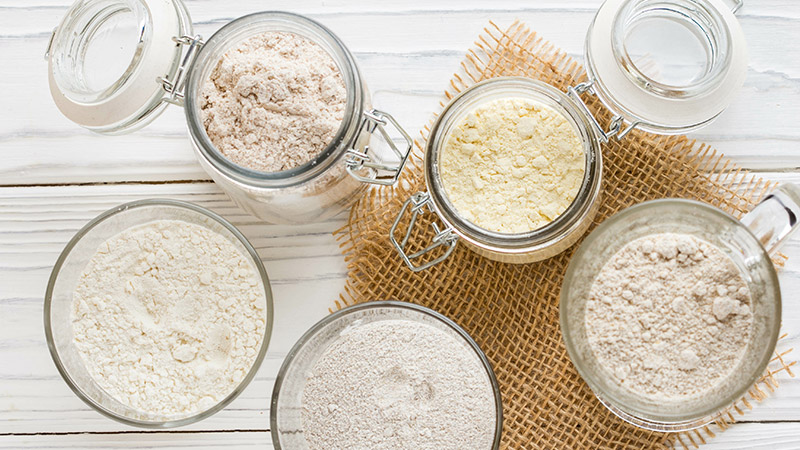
Flour is a primary ingredient in breads, cakes, cookies and quick breads. Here are the main types of flour you’ll find at the grocery store. Stock up on the ones that make the most sense for you and the kind of baking you love to do.
- All-purpose flour: The most commonly used type of flour, all-purpose flour is a blend of medium-gluten wheats that is used in baking everything from pizza dough to pancakes. Available in both bleached and unbleached varieties.
- Whole wheat flour: Made with red wheat, whole wheat flour is darker in color and is full of fiber and nutrients. Bakers often choose whole wheat flour when they want a more flavorful and nutritious alternative to all-purpose flour.
- White whole wheat flour is made from an albino variety of wheat, which is lighter in color, has a sweeter, milder flavor but the same nutritional benefits as whole wheat flour. Both types of whole wheat flour can be used in a wide variety of baking recipes.
- Bread flour: Made from wheat higher in gluten-forming protein, bread flour gives more structure and volume to bread than all-purpose flour. It’s the best choice for making yeast breads and bread-machine breads. It isn’t recommended for cakes, cookies, pastries or quick breads.
- Cake flour: Milled from soft wheat, cake flour has a lower protein content than all-purpose flour and very little gluten. It’s light and finely milled, which results in tender, fine-textured cakes.
- Self-rising flour: Self-rising flour is made from a blend of hard and soft wheats and already includes baking powder and salt, which makes it a great choice for pancakes and biscuits. Unless directed by a recipe, don’t substitute self-rising flour for other types because — you’ll offset the leavening and salt proportions.
Sweeteners
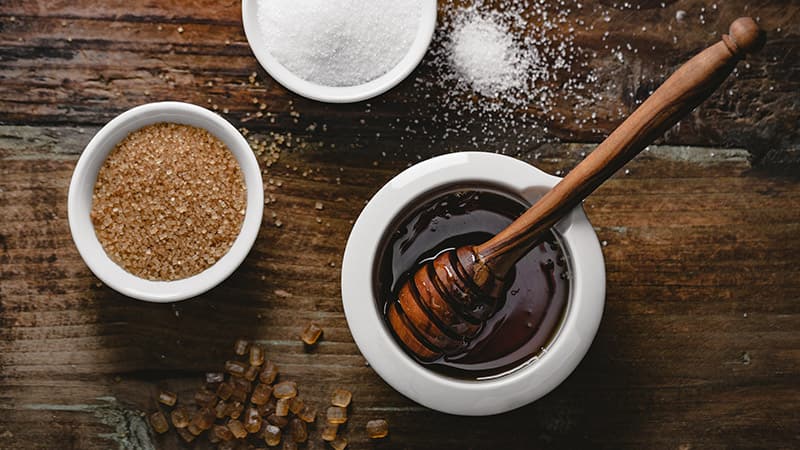
In addition to adding sweetness to baked goods, sweeteners can also add a wonderful caramel flavor to recipes. Most recipes call for granulated sugar, brown sugar or both. However, more and more recipes are calling for less processed alternatives or raw sweeteners, like honey and maple syrup.
-
Granulated sugar: Typically made from sugar beets, or a combination of sugar cane and sugar beets, white granulated sugar is what you should use when a recipe simply calls for “sugar.” It’s available in boxes, bags and cubes.
- Brown sugar: Brown sugar is a mixture of white sugar and molasses and is available in light and dark varieties. Dark brown sugar has more molasses and a stronger flavor than light brown sugar. If brown sugar hardens, try softening it by putting it in a closed container with a slice of apple or fresh bread for one to two days.
- Confectioner's/powdered sugar: Powdered (confectioner’s) sugar is granulated sugar that has been processed to a fine powder. It’s often used to make frostings and desserts like mousse, meringue and sweet cream fillings.
- Unprocessed sugars: Unprocessed sugars — also known as raw sugars like honey, maple syrup, cane and coconut sugar — contain most of their original cane molasses.
- Honey: A natural sweetener produced by bees, honey is safe for persons one year of age and older. Store honey at room temperature.
-
Maple syrup: This golden brown to amber-colored sweetener is made by boiling down the sap of sugar maple trees. Maple-flavored syrup is usually corn syrup combined with a little pure maple syrup. We recommend refrigerating maple syrup after opening.
-
Cane sugar: Made exclusively from sugar cane, cane sugar comes in many forms, including unrefined, raw and refined.
-
Coconut sugar: Also known as coconut palm sugar, coconut sugar is made from the sap of the coconut palm tree. Similar in appearance to brown sugar, coconut sugar comes in crystals/granules, blocks or liquid form.
-
Corn syrup: Made from the naturally occurring sugars in corn, corn syrup is available in light and dark varieties. Light corn syrup has no color and is milder in sweetness, while dark corn syrup contains molasses, resulting in a sweeter flavor and a darker caramel coloring. Corn syrup is often used for candy, jams, jellies, frostings and baked goods.
-
Molasses: A dark thick syrup that results from the sugar-refining process, molasses is available in light (or mild flavor) and dark (full flavor) varieties. Molasses is great for adding moisture and color to baked goods like pecan pie.
Milk and Cream
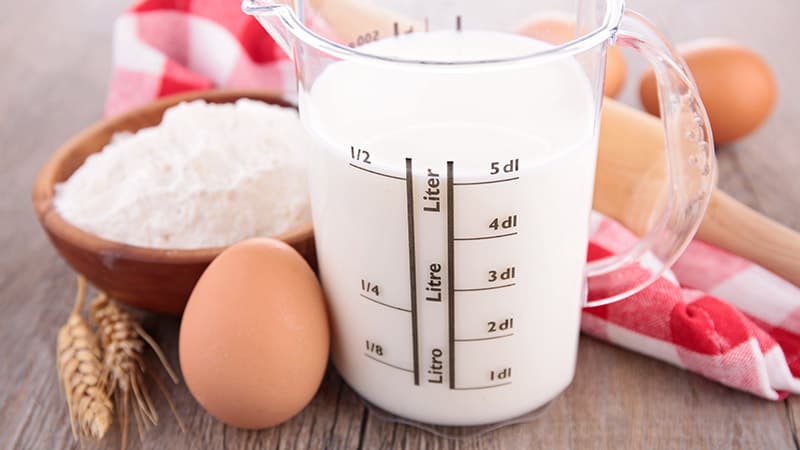
Milk adds moisture to baked goods like breads and cakes and prevents them from becoming too dry. It can also add tenderness to the texture. Keep it stocked in your fridge.
- Milk: This is the most common form of cow’s milk, which is available in whole milk (3.25% milk fat), low-fat milk (1 or 2% milk fat) and nonfat or skim milk.
- Buttermilk: A thick, smooth liquid made from culturing skim or part-skim milk with lactic acid bacteria, buttermilk is versatile and can add lift or “fluffiness” as well as a tangy flavor to baked goods like pancakes, waffles and biscuits.
- Sweetened condensed milk: An ingredient found in many dessert and sweet recipes, sweetened condensed milk is made by removing about half the water from whole milk and adding sweetener in its place, resulting in a thick mixture that’s off-white in color. It also adds tenderness, moisture and flavor as well as color to crusts.
- Evaporated milk: Evaporated milk is made by removing more than half of the water, so it’s a little thicker than whole milk and has a slightly “cooked” taste. It can add a rich thickness to recipes like flan and bread. It’s very shelf stable and can often be a substitute for milk or cream, however, don’t substitute it in recipes calling for sweetened condensed milk.
Chocolate
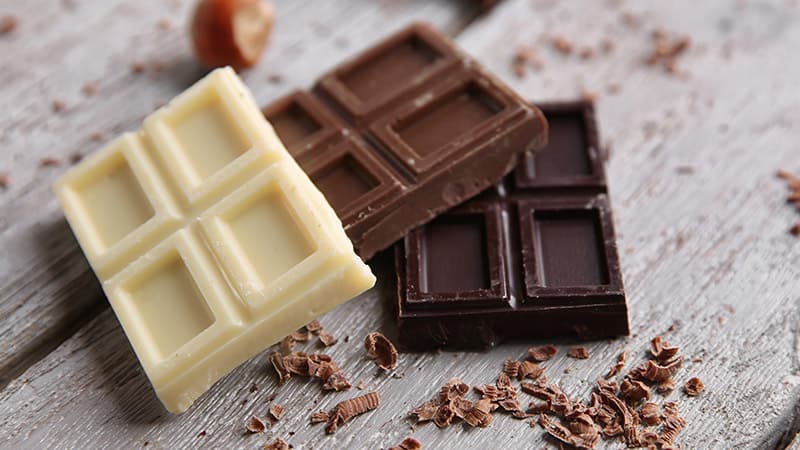
Every Betty loves chocolate! But did you know that it is made from the seeds of the tropical cacao tree? Chocolate is used in a wide variety of baking recipes and each type adds a unique flavor.
- Cocoa powder: Cocoa powder is made by removing the fat, or cocoa butter from the cacao beans during processing, then grinding what’s left into powder. It adds a rich chocolate flavor to desserts.
- White chocolate: Made from sugar, milk and cocoa butter, white chocolate doesn’t contain cocoa solids. It adds a creamy texture and sweet flavor to recipes. When shopping, make sure the label includes cocoa butter — some inexpensive varieties replace this fat with vegetable oil instead.
- Milk chocolate: Though it ranges in quality, milk chocolate contains pure cocoa butter and cocoa solids. It’s sweeter, softer in texture and melts more easily than darker chocolates. Because milk chocolate is sweeter, dark chocolate is often the better choice for baking.
- Dark chocolate: Dark chocolate is generally available in bittersweet and semisweet varieties, both of which are great for baking and can be found in a variety of flavors.
Spices
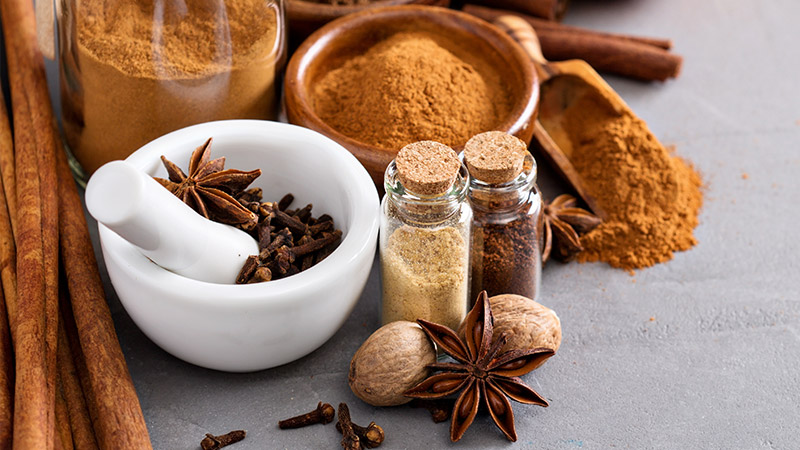
We love what spices add to our recipes — from flavor and aroma to texture and color, it’s hard to imagine baking without them! But where do they come from, anyway? Typically from the bark, buds, fruits, roots, seeds and stems of various plants and trees. Spices are available in grated, ground, powdered and stick or whole form. Here are the most essential spices for your pantry.
- Allspice: A blend of cinnamon, nutmeg and cloves, allspice is often used in cakes, cookies, biscuits and pies.
- Anise seed: With a sweet, licorice flavor, anise can be found in cakes, cookies, fruit fillings and breads.
- Cardamom: The mild ginger-like flavor makes cardamom a great addition to cakes, pastries and even jellies.
- Cinnamon: Known for its warm, spicy flavor, cinnamon is very common in a wide variety of baked goods.
- Ginger: Sweet and spicy with a nice, mild kick, ginger is mostly used in cakes and cookies.
- Nutmeg: Also sweet and spicy in flavor, nutmeg tastes great in breads, cakes, cookies, custards and pies.
- Poppy seed: With a nutlike flavor and a delightful texture, poppy seeds are often used in breads and muffins.
- Vanilla bean: The rich and sweet taste makes vanilla delicious in various treats like cookies, ice cream, pastries and more.
Vinegar
Vinegar is made from fermented liquids, like wine, beer or cider, that have been converted by a bacterial activity to acid. In everything from artisanal breads to the lightest meringues, vinegar acts as a leavening agent (much like baking soda) that helps baked goods rise. Each type of vinegar has a unique flavor.
- Apple cider vinegar: Made from fermented apple cider, this type of vinegar is milder in flavor than white vinegar.
- Balsamic vinegar: Derived from Trebbiano grape juice, balsamic vinegar is aged in wooden barrels over a period of years, which gives it its dark color and pungent, sweet flavor.
- Rice vinegar: Made from fermented rice, rice vinegar had a mild and slightly sweet flavor.
- Wine vinegar: Made from red or white wine and is pleasantly pungent.
Yeast
Yeast is a cornerstone of baking. So many of our favorite baked goods, like pizza crusts and cinnamon rolls, start with yeast as a leavening agent. Simply put, yeast makes dough rise. The combination of warmth, sugar and liquid causes yeast to release carbon dioxide bubbles that make the magic happen. Yeast is very sensitive — too much heat will kill it, and cold will prevent it from growing. Always use yeast before its expiration date
- Quick active or instant dry yeast: This is dehydrated yeast that allows dough to rise in less time than regular yeast and can be mixed right into dry ingredients.
- Active dry yeast: Dehydrated yeast that is used in most yeast dough recipes, active dry yeast is available in moisture-proof packets or jars. Each packet contains 2¼ teaspoons of yeast that needs to be dissolved in water before using.
Stabilizers and Leaveners
These ingredients may sound technical and that’s because they are! Stabilizers and leaveners, like flour, eggs and starches, help baked goods rise and retain their shape after being removed from the oven. You can't have a light and fluffy cake or tall and airy biscuits without them.
- Baking powder: A dry leavening agent, baking powder increases the volume while lightening the texture of baked goods. When combined with liquid, baking powder causes batter to expand and rise.
- Baking soda: One of the most widely used leaveners in baked goods, baking soda is a fine powder for use in cooking that is used to leaven many “quick breads” like pancakes, muffins and cakes. But whatever you do, don't try to substitute baking soda for baking powder. It won't work!
- Cream of tartar: Acids left in wine barrels after wine is made are processed into cream of tartar. When added to egg whites before beating, cream of tartar increases the stability and volume of baked goods.
Eggs
The incredible egg is used as a key ingredient in everything from cookies and breads to meringues and pastry cream. Eggs add structure as well as moisture to baked goods and can also act as a glue or glaze in some recipes. Although most brown and white-shelled eggs have the same flavor and nutritional value, pay attention to the size of your egg — the bigger the egg, the more liquid you’ll add to your recipe.
- Pasteurized eggs: Also called fat-free egg product, pasteurized eggs are liquid eggs that are sold in cartons and can be found in your grocery store’s refrigeration section. The white and yellow yolks are mixed together and then pasteurized at a heat level that kills any bacteria without cooking the eggs. Pasteurized eggs are used in recipes that don’t require cooking or baking.
Fats and Oils
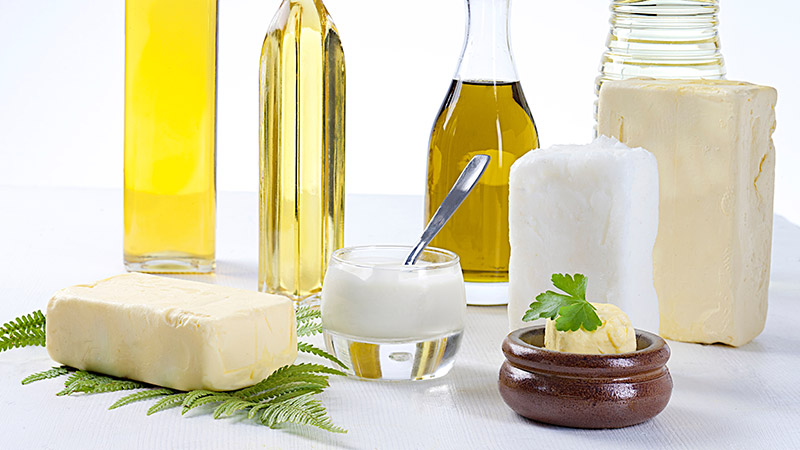
Fats and oils are used in baked goods to tenderize, add richness and flavor, aid in browning and help bind ingredients together.
- Butter: Butter is a saturated fat made from cream, and it has a wonderful flavor and a melt-in-your-mouth texture. Available in lightly-salted and unsalted (or sweet) varieties, butter comes in sticks, tubs and butter-flavored granules.
- Oils: There are several different types of oils (or liquid fats) that can be used in baking, and each adds a unique texture, level of moisture and flavor, which becomes especially important when you are baking cakes and quick breads.
- Olive oil: Olive oil is made from pressed olives and classified in several ways: extra virgin, virgin, olive oil and light olive oil. Olive oil ranges in color from dark green to light yellow, and can taste spicy to mellow.
- Vegetable oil: A blend of oils from various vegetables, such as corn, cottonseed, peanut, safflower, canola and soybean, vegetable oil has a very mild flavor.
- Shortening: Usually made from soybean, cottonseed, or palm oils, shortening has the consistency of soft butter and is white in color and neutral in flavor. You can find shortening in resealable canisters or baking sticks, which can be used interchangeably.
- Baking or cooking sprays: Available in regular (or unflavored) butter and olive oil varieties, cooking spray can be used to spray baking pans and prevent food from sticking. Baking spray with flour combines unflavored cooking oil with real flour and is used primarily for spraying baking pans.
(function() {
document.addEventListener('DOMContentLoaded', function() {
var componentMetadata = JSON.parse('\x7b\x22componentName\x22\x3a\x22NewsletterCTA_b9911a56-3a0d-4b1c-8521-df6c10ce048a\x22,\x22deferOptions\x22\x3a\x7b\x22deferComponent\x22\x3atrue,\x22deferType\x22\x3a\x22OnDemand\x22,\x22deferId\x22\x3a\x22rb1c7865cb15e4ffa8005ba5b9709b50d\x22,\x22deferredContainerId\x22\x3a\x22\x2fprimaryColumn\x2finteropInlineNewsletterCta\x22,\x22deferredContainerView\x22\x3a\x22InteropDeferWrapper\x22\x7d,\x22viewName\x22\x3a\x22NewsletterCTA\x22\x7d');
var configuration = {"unsubscribedNewsletters":[{"listId":"1e34a555-89d1-45f0-8f07-b3ae6b01c03c","thumbnailImageUrl":"/-/media/GMI/Core-Sites/BC/Images/Shared/myaccount/newsletters/BC_Thumb157x157.png?sc_lang=en","previewUrl":"https://morpheus3.idpk.net/email_sends/9111/preview","name":"Betty\u0027s Email","isPromo":false}],"settings":{"anonymousCopy":"Ready to Be Inspired?","anonymousDescriptionCopy":"We know you’ll love our daily tips, trends and tasty recipes sent right to your inbox.","anonymousThankYouCopy":"\u003cp\u003eThanks! Your first email is on its way.\u003c/p\u003e\n","anonymousThankYouDescriptionCopy":"\u003cp\u003e\u003cspan\u003eNow that you\u0026rsquo;re signed up, create an account on BettyCrocker.com to save your favorite recipes, learn more about special promotions and get inspired through Betty\u0026rsquo;s expert tips.\u003c/span\u003e\u003c/p\u003e","anonymousButtonText":"Sign up now","anonymousEmailInvalidErrorText":"Please enter a valid email address.","anonymousSubscribeErrorText":"We encountered an error while signing you up. Please try again.","anonymousEmailAddressPlaceholderText":"Enter your email address","anonymousEmailAddressLabel":"Email Address","anonymousLegalCopy":"By signing up, you accept our\u0026nbsp;\u003ca rel=\u0022noopener noreferrer\u0022 href=\u0022https://www.generalmills.com/privacy-security/us-english-privacy-policy\u0022 target=\u0022_blank\u0022\u003e\u003cspan style=\u0022text-decoration: underline;\u0022\u003ePrivacy Policy\u003c/span\u003e\u003c/a\u003e\u0026nbsp;and agree that your information may be used across our\u0026nbsp;\u003ca rel=\u0022noopener noreferrer\u0022 href=\u0022https://www.generalmills.com/food-we-make/brands\u0022 target=\u0022_blank\u0022\u003e\u003cspan style=\u0022text-decoration: underline;\u0022\u003efamily of brands\u003c/span\u003e.\u003c/a\u003e","requiredFieldText":"","standardSmallImageUrl":"/-/media/GMI/Core-Sites/BC/Images/BC/seasonal/2021_Christmas/ncta_bg.png","standardLargeImageUrl":"/-/media/GMI/Core-Sites/BC/Images/BC/seasonal/2021_Christmas/ncta_bg.png","backgroundColor":"#333333","accentColor":"","registrationUrl":"/register/reg-fp?RegAction=SUBSCRIBERUPGRADE\u0026esrc=11275\u0026returnUrl=%2fHow-To%2fTipsLibrary%2fIngredients%2fWhat-To-Know-About-Ingredients","registrationLinkText":"Join free!","enableExpandedFields":false,"hideForSessionCookieExpiration":0,"ctaType":"StandardAnonymous","location":"Inline","userState":"Anonymous","sourceCodeOverride":0}};
var moduleName = 'newsletterCta';
var isVueModule = true;
GeneralMills.PandoSites.RegisterControlInstance(moduleName, configuration, componentMetadata, isVueModule)
});
})();
(function() {
document.addEventListener('DOMContentLoaded', function() {
var componentMetadata = JSON.parse('\x7b\x22componentName\x22\x3a\x22ConsumerGeneratedContent_a981d21b-3400-4574-916f-67f91c8a7ee0\x22,\x22deferOptions\x22\x3a\x7b\x22deferComponent\x22\x3atrue,\x22deferType\x22\x3a\x22OnDemand\x22,\x22deferId\x22\x3a\x22rb78eda7c5c5e4329a88e4be346c29171\x22,\x22deferredContainerId\x22\x3a\x22\x2fratingReview\x2finteropRatingReview\x22,\x22deferredContainerView\x22\x3a\x22InteropDeferWrapper\x22\x7d,\x22viewName\x22\x3a\x22ConsumerGeneratedContent\x22\x7d');
var configuration = {"loaderScript":"https://apps.bazaarvoice.com/deployments/bettycrocker/main_site/production/en_US/bv.js","type":"QuestionAndAnswer","language":"en","includeRatings":false};
var moduleName = 'consumerGeneratedContent';
var isVueModule = true;
GeneralMills.PandoSites.RegisterControlInstance(moduleName, configuration, componentMetadata, isVueModule)
});
})();